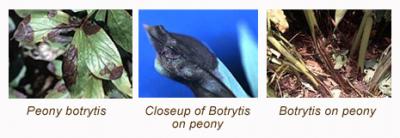Botrytis (Gray Mold) and anthracnose often cause similar damage. Botrytis and anthracnose can infect buds, flowers, leaves, and stems. Infected tissue turns dark brown and dies. The first symptoms are small spots that enlarge with time. The flower bud may be killed (bud blast). Entire leaves may die. Spots usually become elongated streaks that may grow down into the tuber. If that happens, the plant usually begins to die out over a number of years.
Paeona sp. (Peony) get botrytis and anthracnose. Culturing in a lab is usually necessary for proper identification.
Botrytis can infect plants when temperatures are between 32 and 84 degrees Spores are released on a rising as well as a lowering humidity. However free standing moisture is required for infection. The fungus can over winter on live and dead plant material.
Anthracnose needs free standing moisture to infect.
Fungicides and sanitation are helpful.
Grow in full sun and good air circulation
